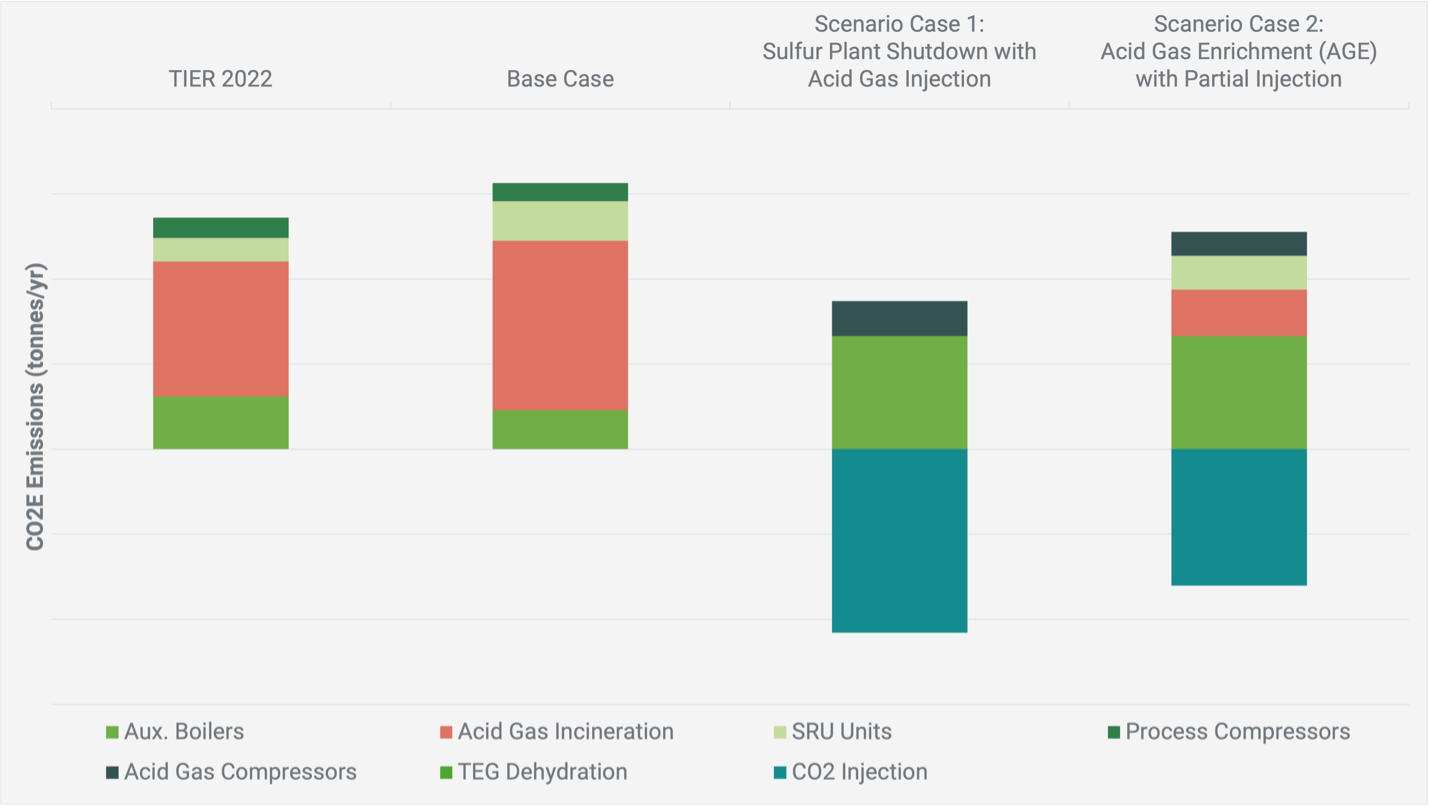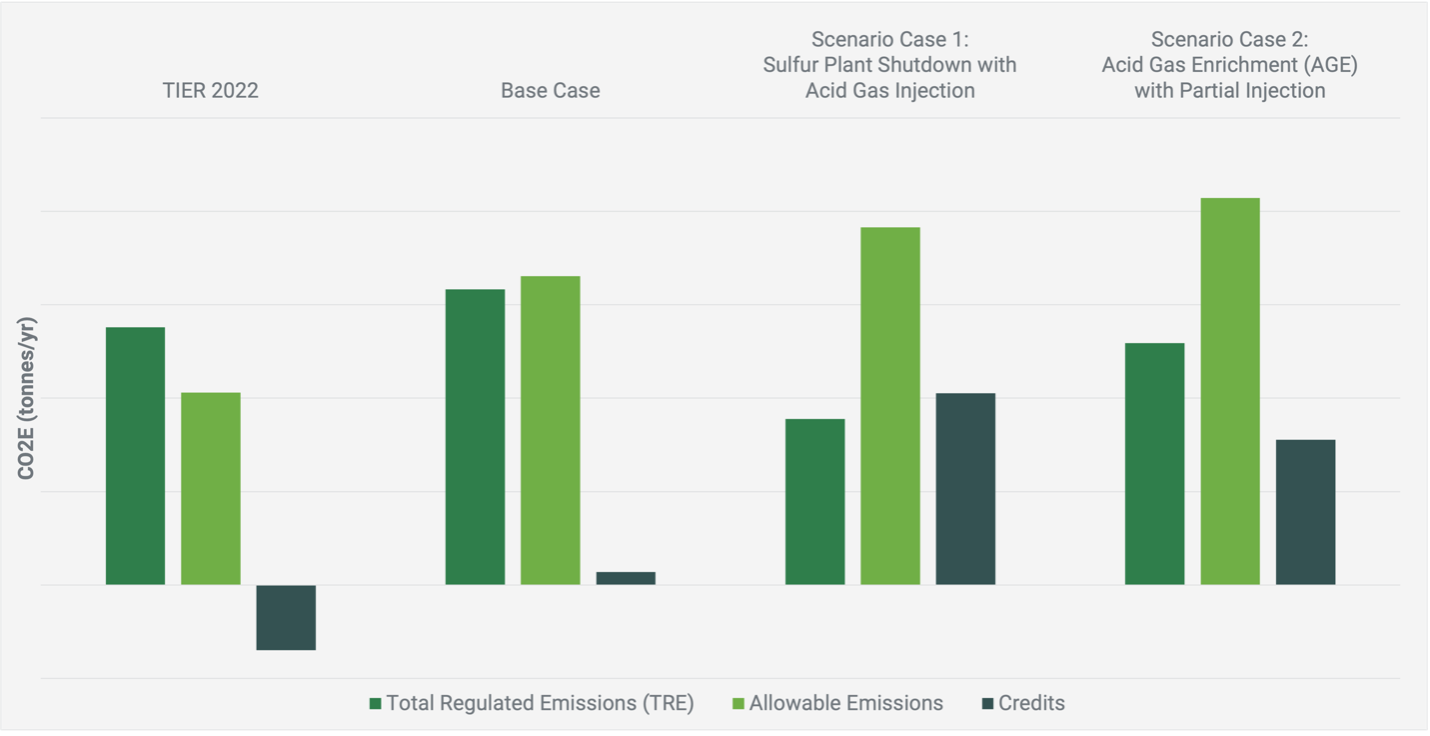Acid Gas System Redesign Evaluation for Major GHG Emissions Reduction
An oil and gas company requested Process Ecology to conduct a Preliminary Front-End Engineering and Design (Pre-FEED) or conceptual engineering study to assess potential modifications to the sulfur plant at a sour gas plant emitting more than 100,000 tonnes of carbon dioxide (CO2) equivalent per year.
The primary goal was to reduce greenhouse gas (GHG) emissions and associated carbon tax costs related to acid gas incineration through optimized acid gas management.
Acid gas injection is a viable solution to mitigate GHG emissions and potentially decommission the sulfur recovery plant.
Background
The client's sour gas processing facility processes substantial volumes of natural gas, resulting in annual emissions exceeding 100,000 tonnes of carbon dioxide equivalent (CO₂e). The primary sources of these emissions include:
- Acid Gas Incineration: High levels of formation CO₂ are released during the incineration process downstream of the sulfur recovery unit.
- Stationary Fuel Gas Combustion: Combustion processes contribute additional CO₂ emissions.
Recognizing the financial and environmental impacts, including carbon taxes under Alberta's Technology Innovation and Emissions Reduction (TIER) regulation, the client sought innovative solutions to reduce emissions.
Acid gas injection (AGI) is a method for reducing emissions from acid gas incineration by compressing low-pressure acid gas stream, primarily hydrogen sulfide (H₂S) and carbon dioxide (CO₂), to sufficient pressure for underground injection, preventing their release into the atmosphere. This process also supports carbon sequestration by permanently storing CO₂, offering a more efficient and environmentally friendly alternative to acid gas incineration.
The client asked Process Ecology to assess the feasibility of AGI for their facility, quantify emissions reductions, and estimate carbon credits and capital costs.
Objectives
The primary objectives of the Pre-FEED study were to:
- Assess Modification Options: Evaluate and compare different process configurations for installing acid gas injection compressor units and reducing GHG emissions.
- Quantify Emissions Reductions: Calculate potential decreases in total regulated CO₂e emissions (TRE) for each scenario.
- Estimate Economic Impacts: Determine the associated carbon credits and perform Class 5 cost estimates for proposed modifications.
- Support Decision-Making: Provide comprehensive data and analysis to guide the client towards the most effective and cost-efficient solution.
Methodology
Process Ecology employed a systematic approach which included a process simulation, energy balance assessment, and economic analysis.
The methodology included the following phases: 1. Establishing the base case, 2. Developing case scenarios, 3. Comprehensive assessment, and 4. Economic evaluation.
1. Establishing the Base Case:
This step includes establishing a base process simulation model and validating it with plant data representing full-capacity plant operations. This also includes calculating current GHG emissions following the Alberta TIER regulatory framework to serve as a reference point for comparison with proposed scenarios
2. Scenario Analysis:
Two alternative process scenarios were developed and analyzed:
- Scenario Case 1: Sulfur Plant Shutdown with Acid Gas Injection
Developed a model and quantified emissions for a case where the sulfur plant is shut-in and is replaced with an acid gas injection compressor train with inter-stage cooling and Methanol Injection
- Scenario Case 2: Acid Gas Enrichment (AGE) with Partial Injection
Develop a model and quantify emissions for a case where an AGE process involving new contactor and regenerator columns are incorporated to produce a hydrogen sulfide (H₂S)-rich stream for sulfur recovery, while directing the CO₂-rich stream to an acid gas injection system equipped with a dehydration package.

Block Flow Diagram of Scenario 2 Process Configuration
3. Comprehensive Assessment:
This step requires an assessment of the energy balance, fuel consumption, steam requirement, GHG emissions, and carbon credits for all the cases. GHG emissions were reported following the Alberta TIER format.
4. Economic Evaluation:
To calculate the credits generated from these processes, the allowable emissions for this site under Alberta TIER regulations need to be determined.
5. Carbon Credits and Regulatory Compliance:
The Alberta TIER regulation uses a modular approach to establish facility-specific allowable emissions, with separate emissions intensity weightings assigned to each process stage. The sum of these weighted modules produces a standardized production metric known as the Alberta Gas Processing Index (ABGPI). Key calculations included:
- Product Allocations = Facility Specific Benchmark (FSB) × ABGPI
- Allowable Emissions = Product Allocations - Indirect Emissions
- Credits = Total Regulated Emissions - Allowable Emissions
Based on the throughput and TRE calculations, ABGPI and Carbon Credits were determined for all cases for the year 2024. These were calculated using a Facility Specific Benchmark (FSB), which requires the facility to reduce emissions intensity relative to its historical production-weighted average emissions intensity.
Lastly, Class 5 cost estimates were completed following AACE (Association for the Advancement of Cost Engineering) guidelines to project capital and operational expenditures for each scenario.
Results: Emissions Reductions and Economic Impacts
Emissions Reductions:

Waterfall Chart Comparing TRE Across Base Case and Scenarios 1 & 2
Key Findings:
- Base Case: TRE were 15% higher compared to TIER 2022 reported emissions, primarily due to increased throughput leading to elevated acid gas incineration emissions.
- Scenario case 1: Sulfur Plant Shutdown with Acid Gas Injection: Achieved approximately 40% reduction in TRE compared to the base case, significantly lowering GHG emissions by capturing and injecting formation CO₂.
- Scenario Case 1 and Case 2: Both scenarios showed increased emissions compared to the base case from auxiliary boilers due to reduced steam generation from the decommissioned sulfur plant.
- Scenario Case 2: Higher TRE compared to Sulfur plant shutdown. The increased emissions can be primarily attributed to the required duty for regeneration of the amine in the AGE plant and incineration of a portion of the formation CO2 that remains in the enriched acid gas. Despite higher complexity, this scenario provided a balanced approach between emissions reduction and sulfur recovery continuity.
Economic Impacts:

Chart Summarizing Carbon Credits for Each Scenario
Key Findings:
- Base Case: Increased throughput resulted in higher allowable emissions under TIER regulations, enabling moderate carbon credits compared to previous years where carbon taxes were owed.
- Scenario Case 1: Projected to generate approximately 100,000 tonnes/year in EPCs, translating to significant financial savings and potential revenue through carbon credit trading.
- Scenario Case 2: Demonstrated that expected EPCs were lower than Scenario 1 due to additional emissions from AGE processing, yet still provided meaningful economic benefits.
Cost Estimation
Key Findings:
- Scenario Case 1: Lower capital and operational costs due to the elimination of sulfur recovery infrastructure and simpler process modifications.
- Scenario Case 2: Higher costs associated with installing new AGE equipment and maintaining dual processing streams.
Conclusion
Process Ecology's comprehensive Pre-FEED study provided the client with detailed insights into the technical and economic feasibility of modifying their sulfur plant operations to achieve substantial GHG emissions reductions.
Recommendations:
- Adopt Scenario Case 1: The sulfur plant shutdown with acid gas injection offers the most significant emissions reductions and economic benefits, aligning with sustainability goals and regulatory compliance.
- Proceed to FEED Stage: Based on the favourable outcomes, it is recommended to advance Scenario Case 1 to the FEED phase for detailed engineering and implementation planning.
This study enabled informed decision-making through robust process simulation and data analysis. It also demonstrated expertise in conceptual process design, emissions quantification, and regulatory navigation.
The client now can achieve long-term environmental compliance and financial savings through optimized operations.
For more information on how Process Ecology can assist in optimizing your facility's environmental performance and achieving regulatory compliance, contact us today.
Contact us via email at info@processecology.com
Follow us on LinkedIn for updates: Process Ecology Inc.
Subscribe to our newsletter today!
About the authors:
Chahat Aggarwal, MASc
Ahad Sarraf Shirazi, M.Sc., P. Eng.
